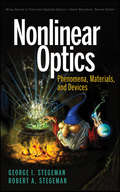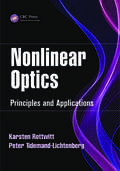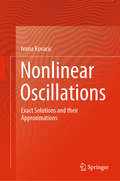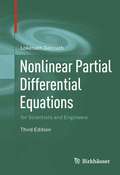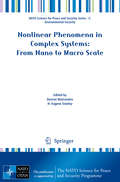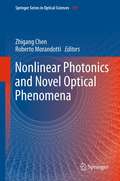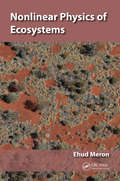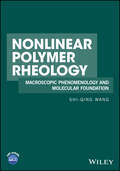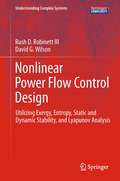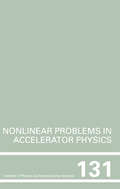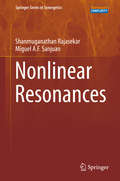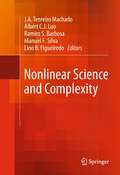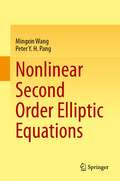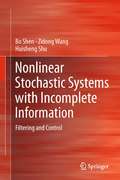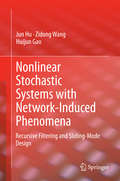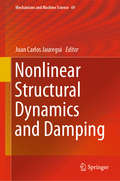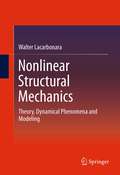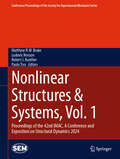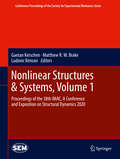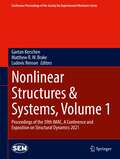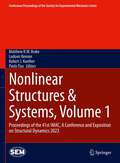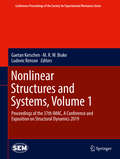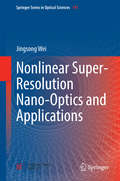- Table View
- List View
Nonlinear Optics: Phenomena, Materials, and Devices
by George I. Stegeman Robert A. StegemanClear, integrated coverage of all aspects of nonlinear optics--phenomena, materials, and devices Coauthored by George Stegeman, one of the most highly respected pioneers of nonlinear optics--with contributions on applications from Robert Stegeman--this book covers nonlinear optics from a combined physics, optics, materials science, and devices perspective. It offers a thoroughly balanced treatment of concepts, nonlinear materials, practical aspects of nonlinear devices, and current application areas. Beginning with the presentation of a simple electron on a spring model--to help readers make the leap from concepts to applications--Nonlinear Optics gives comprehensive explanations of second-order phenomena, derivation of nonlinear susceptibilities, third-order nonlinear effects, multi-wave mixing, scattering, and more. Coverage includes: Nonlinear response of materials at the molecular level Second-order nonlinear devices, their optimization and limitations The physical origins of second- and third-order nonlinearities Typical frequency dispersion of nonlinearities, explained in terms of simple two- and three-level models Ultrafast and ultrahigh intensity processes Practice problems demonstrating the design of such nonlinear devices as frequency doublers and optical oscillators Based on more than twenty years of lectures at the College of Optics and Photonics (CREOL) at the University of Central Florida, Nonlinear Optics introduces all topics from the ground up, making the material easily accessible not only for physicists, but also for chemists and materials scientists, as well as professionals in diverse areas of optics, from laser physics to electrical engineering.
Nonlinear Optics: Principles and Applications (Optical Sciences and Applications of Light)
by Karsten Rottwitt Peter Tidemand-LichtenbergThis book describes the fundamental aspects of nonlinear optics from basic principles to applications. Starting from the polarization induced by an electric field in a material, it relates the induced polarization to the propagating fields. It describes the properties of the induced polarization through a material response expressed both in the time and frequency domains leading to the nonlinear wave equation. The second part of the book focuses on applications of nonlinear interaction between light and matter, and considers nonlinearities in crystals and optical fibers.
Nonlinear Oscillations: Exact Solutions and their Approximations
by Ivana KovacicThis book presents exact, closed-form solutions for the response of a variety of nonlinear oscillators (free, damped, forced). The solutions presented are expressed in terms of special functions. To help the reader understand these `non-standard' functions, detailed explanations and rich illustrations of their meanings and contents are provided. In addition, it is shown that these exact solutions in certain cases comprise the well-known approximate solutions for some nonlinear oscillations.
Nonlinear Partial Differential Equations for Scientists and Engineers
by Lokenath DebnathThe revised and enlarged third edition of this successful book presents a comprehensive and systematic treatment of linear and nonlinear partial differential equations and their varied and updated applications. In an effort to make the book more useful for a diverse readership, updated modern examples of applications are chosen from areas of fluid dynamics, gas dynamics, plasma physics, nonlinear dynamics, quantum mechanics, nonlinear optics, acoustics, and wave propagation. Nonlinear Partial Differential Equations for Scientists and Engineers, Third Edition, improves on an already highly complete and accessible resource for graduate students and professionals in mathematics, physics, science, and engineering. It may be used to great effect as a course textbook, research reference, or self-study guide.
Nonlinear Phenomena in Complex Systems: From Nano to Macro Scale
by Davron Matrasulov H. Eugene StanleyTopics of complex system physics and their interdisciplinary applications to different problems in seismology, biology, economy, sociology, energy and nanotechnology are covered in this new work from renowned experts in their fields. In particular, contributed papers contain original results on network science, earthquake dynamics, econophysics, sociophysics, nanoscience and biological physics. Most of the papers use interdisciplinary approaches based on statistical physics, quantum physics and other topics of complex system physics. Papers on econophysics and sociophysics are focussed on societal aspects of physics such as, opinion dynamics, public debates and financial and economic stability. This work will be of interest to statistical physicists, economists, biologists, seismologists and all scientists working in interdisciplinary topics of complexity.
Nonlinear Photonics and Novel Optical Phenomena
by Zhigang Chen Roberto MorandottiNonlinear Photonics and Novel Optical Phenomena contains contributed chapters from leading experts in nonlinear optics and photonics, and provides a comprehensive survey of fundamental concepts as well as hot topics in current research on nonlinear optical waves and related novel phenomena. The book covers self-accelerating airy beams, integrated photonics based on high index doped-silica glass, linear and nonlinear spatial beam dynamics in photonic lattices and waveguide arrays, the theory of polariton solitons in semiconductor microcavities, and Terahertz waves.
Nonlinear Physics of Ecosystems
by Ehud MeronNonlinear Physics of Ecosystems introduces the concepts and tools of pattern formation theory and demonstrates their utility in ecological research using problems from spatial ecology. Written in language understandable to both physicists and ecologists in most parts, the book reveals the mechanisms of pattern formation and pattern dynamics. It als
Nonlinear Polymer Rheology: Macroscopic Phenomenology And Molecular Foundation
by Shi-Qing WangIntegrating latest research results and characterization techniques, this book helps readers understand and apply fundamental principles in nonlinear polymer rheology. The author connects the basic theoretical framework with practical polymer processing, which aids practicing scientists and engineers to go beyond the existing knowledge and explore new applications. Although it is not written as a textbook, the content can be used in an upper undergraduate and first year graduate course on polymer rheology.• Describes the emerging phenomena and associated conceptual understanding in the field of nonlinear polymer rheology• Incorporates details on latest experimental discoveries and provides new methodology for research in polymer rheology• Integrates latest research results and new characterization techniques like particle tracking velocimetric method • Focuses on the issues concerning the conceptual and phenomenological foundations for polymer rheology• Has a companion website for readers to access with videos complementing the content within several chapters
Nonlinear Power Flow Control Design
by Rush D. Robinett III David G. WilsonThis book presents an innovative control system design process motivated by renewable energy electric grid integration problems. The concepts developed result from the convergence of research and development goals which have important concepts in common: exergy flow, limit cycles, and balance between competing power flows. A unique set of criteria is proposed to design controllers for a class of nonlinear systems. A combination of thermodynamics with Hamiltonian systems provides the theoretical foundation which is then realized in a series of connected case studies. It allows the process of control design to be viewed as a power flow control problem, balancing the power flowing into a system against that being dissipated within it and dependent on the power being stored in it - an interplay between kinetic and potential energies. Human factors and the sustainability of self-organizing systems are dealt with as advanced topics.
Nonlinear Problems in Accelerator Physics, Proceedings of the INT workshop on nonlinear problems in accelerator physics held in Berlin, Germany, 30 March - 2 April, 1992
by Martin BerzNonlinear Problems in Accelerator Physics contains the proceedings of the International Workshop on Nonlinear Problems in Accelerator Physics. Consisting only of invited papers, the book focuses on resolving problems associated with nonlinear effects-essential for the development of the next generation of particle accelerators. It facilitates an understanding of accelerator optical systems. Topics covered include Hamiltonian dynamics (such as CHAOS), computer codes for design of focusing systems, and spectrometers. The book is of interest to researchers in high energy, nuclear, electron, ion and optical beam physics, and applied mathematics.
Nonlinear Resonances
by Shanmuganathan Rajasekar Miguel A.F. SanjuanThis introductory text presents the basic aspects and most important features of various types of resonances and anti-resonances in dynamical systems. In particular, for each resonance, it covers the theoretical concepts, illustrates them with case studies, and reviews the available information on mechanisms, characterization, numerical simulations, experimental realizations, possible quantum analogues, applications and significant advances made over the years. Resonances are one of the most fundamental phenomena exhibited by nonlinear systems and refer to specific realizations of maximum response of a system due to the ability of that system to store and transfer energy received from an external forcing source. Resonances are of particular importance in physical, engineering and biological systems - they can prove to be advantageous in many applications, while leading to instability and even disasters in others. The book is self-contained, providing the details of mathematical derivations and techniques involved in numerical simulations. Though primarily intended for graduate students, it can also be considered a reference book for any researcher interested in the dynamics of resonant phenomena.
Nonlinear Science and Complexity
by Albert C. Luo J.A. Tenreiro Machado Lino B. Figueiredo Manuel F. Silva Ramiro S. BarbosaThis book contains selected papers of NSC08, the 2nd Conference on Nonlinear Science and Complexity, held 28-31 July, 2008, Porto, Portugal. It focuses on fundamental theories and principles, analytical and symbolic approaches, computational techniques in nonlinear physics and mathematics. Topics treated include * Chaotic Dynamics and Transport in Classic and Quantum Systems * Complexity and Nonlinearity in Molecular Dynamics and Nano-Science * Complexity and Fractals in Nonlinear Biological Physics and Social Systems * Lie Group Analysis and Applications in Nonlinear Science * Nonlinear Hydrodynamics and Turbulence * Bifurcation and Stability in Nonlinear Dynamic Systems * Nonlinear Oscillations and Control with Applications * Celestial Physics and Deep Space Exploration * Nonlinear Mechanics and Nonlinear Structural Dynamics * Non-smooth Systems and Hybrid Systems * Fractional dynamical systems
Nonlinear Second Order Elliptic Equations
by Mingxin Wang Peter Y. PangThis book focuses on the following three topics in the theory of boundary value problems of nonlinear second order elliptic partial differential equations and systems: (i) eigenvalue problem, (ii) upper and lower solutions method, (iii) topological degree method, and deals with the existence of solutions, more specifically non-constant positive solutions, as well as the uniqueness, stability and asymptotic behavior of such solutions.While not all-encompassing, these topics represent major approaches to the theory of partial differential equations and systems, and should be of significant interest to graduate students and researchers. Two appendices have been included to provide a good gauge of the prerequisites for this book and make it reasonably self-contained.A notable strength of the book is that it contains a large number of substantial examples. Exercises for the reader are also included. Therefore, this book is suitable as a textbook for graduate students who havealready had an introductory course on PDE and some familiarity with functional analysis and nonlinear functional analysis, and as a reference for researchers.
Nonlinear Solid Mechanics For Finite Element Analysis: Statics
by Javier Bonet Antonio J. Gil Richard D. WoodDesigning engineering components that make optimal use of materials requires consideration of the nonlinear static and dynamic characteristics associated with both manufacturing and working environments. The modeling of these characteristics can only be done through numerical formulation and simulation, which requires an understanding of both the theoretical background and associated computer solution techniques. By presenting both the nonlinear solid mechanics and the associated finite element techniques together, the authors provide, in the first of two books in this series, a complete, clear, and unified treatment of the static aspects of nonlinear solid mechanics. Alongside a range of worked examples and exercises are user instructions, program descriptions, and examples for the FLagSHyP MATLAB computer implementation, for which the source code is available online. While this book is designed to complement postgraduate courses, it is also relevant to those in industry requiring an appreciation of the way their computer simulation programs work.
Nonlinear Solid Mechanics: Bifurcation Theory and Material Instability
by Davide BigoniThis book covers solid mechanics for non-linear elastic and elastoplastic materials, describing the behaviour of ductile material subject to extreme mechanical loading and its eventual failure. The book highlights constitutive features to describe the behaviour of frictional materials such as geological media. On the basis of this theory, including large strain and inelastic behaviours, bifurcation and instability are developed with a special focus on the modelling of the emergence of local instabilities such as shear band formation and flutter of a continuum. The former is regarded as a precursor of fracture, while the latter is typical of granular materials. The treatment is complemented with qualitative experiments, illustrations from everyday life and simple examples taken from structural mechanics.
Nonlinear Stochastic Systems with Incomplete Information
by Huisheng Shu Zidong Wang Bo ShenNonlinear Stochastic Processes addresses the frequently-encountered problem of incomplete information. The causes of this problem considered here include: missing measurements; sensor delays and saturation; quantization effects; and signal sampling. Divided into three parts, the text begins with a focus on H filtering and control problems associated with general classes of nonlinear stochastic discrete-time systems. Filtering problems are considered in the second part, and in the third the theory and techniques previously developed are applied to the solution of issues arising in complex networks with the design of sampled-data-based controllers and filters. Among its highlights, the text provides: * a unified framework for filtering and control problems in complex communication networks with limited bandwidth; * new concepts such as random sensor and signal saturations for more realistic modeling; and * demonstration of the use of techniques such as the Hamilton-Jacobi-Isaacs, difference linear matrix, and parameter-dependent matrix inequalities and sums of squares to handle the computational challenges inherent in these systems. The collection of recent research results presented in Nonlinear Stochastic Processes will be of interest to academic researchers in control and signal processing. Graduate students working with communication networks with lossy information and control of stochastic systems will also benefit from reading the book.
Nonlinear Stochastic Systems with Network-Induced Phenomena
by Zidong Wang Huijun Gao Jun HuThis monograph introduces methods for handling filtering and control problems in nonlinear stochastic systems arising from network-induced phenomena consequent on limited communication capacity. Such phenomena include communication delay, packet dropout, signal quantization or saturation, randomly occurring nonlinearities and randomly occurring uncertainties. The text is self-contained, beginning with an introduction to nonlinear stochastic systems, network-induced phenomena and filtering and control, moving through a collection of the latest research results which focuses on the three aspects of: · the state-of-the-art of nonlinear filtering and control; · recent advances in recursive filtering and sliding mode control; and · their potential for application in networked control systems, and concluding with some ideas for future research work. New concepts such as the randomly occurring uncertainty and the probability-constrained performance index are proposed to make the network models as realistic as possible. The power of combinations of such recent tools as the completing-the-square and sums-of-squares techniques, HamiltonJacobiIsaacs matrix inequalities, difference linear matrix inequalities and parameter-dependent matrix inequalities is exploited in treating the mathematical and computational challenges arising from nonlinearity and stochasticity. Nonlinear Stochastic Systems with Network-Induced Phenomena establishes a unified framework of control and filtering which will be of value to academic researchers in bringing structure to problems associated with an important class of networked system and offering new means of solving them. The significance of the new concepts, models and methods presented for practical control engineering and signal processing will also make it a valuable reference for engineers dealing with nonlinear control and filtering problems.
Nonlinear Structural Dynamics and Damping (Mechanisms and Machine Science #69)
by Juan Carlos JaureguiThis book compiles recent research in the field of nonlinear dynamics, vibrations and damping applied to engineering structures. It addresses the modeling of nonlinear vibrations in beams, frames and complex mechanical systems, as well as the modeling of damping systems and viscoelastic materials applied to structural dynamics. The book includes several chapters related to solution techniques and signal analysis techniques. Last but not least, it deals with the identification of nonlinear responses applied to condition monitoring systems.
Nonlinear Structural Mechanics
by Walter LacarbonaraThis book reviews the theoretical framework of nonlinear mechanics, covering computational methods, applications, parametric investigations of nonlinear phenomena and mechanical interpretation towards design. Builds skills via increasing levels of complexity.
Nonlinear Structures & Systems, Vol. 1: Proceedings of the 42nd IMAC, A Conference and Exposition on Structural Dynamics 2024 (Conference Proceedings of the Society for Experimental Mechanics Series)
by Matthew R. W. Brake Ludovic Renson Paolo Tiso Robert J. KuetherNonlinear Structures & Systems, Volume 1: Proceedings of the 42nd IMAC, A Conference and Exposition on Structural Dynamics, 2024, the first volume of ten from the Conference brings together contributions to this important area of research and engineering. The collection presents early findings and case studies on fundamental and applied aspects of Nonlinear Dynamics, including papers on: Experimental Nonlinear Dynamics Jointed Structures: Identification, Mechanics, Dynamics Nonlinear Damping Nonlinear Modeling and Simulation Nonlinear Reduced-Order Modeling Nonlinearity and System Identification
Nonlinear Structures & Systems, Volume 1: Proceedings of the 38th IMAC, A Conference and Exposition on Structural Dynamics 2020 (Conference Proceedings of the Society for Experimental Mechanics Series)
by Gaetan Kerschen Matthew R. W. Brake Ludovic RensonNonlinear Structures & Systems, Volume 1: Proceedings of the 38th IMAC, A Conference and Exposition on Structural Dynamics, 2020, the first volume of eight from the Conference brings together contributions to this important area of research and engineering. The collection presents early findings and case studies on fundamental and applied aspects of Nonlinear Dynamics, including papers on:Nonlinear Reduced-order ModelingJointed Structures: Identification, Mechanics, DynamicsExperimental Nonlinear DynamicsNonlinear Model & Modal InteractionsNonlinear DampingNonlinear Modeling & SimulationNonlinearity & System Identification
Nonlinear Structures & Systems, Volume 1: Proceedings of the 39th IMAC, A Conference and Exposition on Structural Dynamics 2021 (Conference Proceedings of the Society for Experimental Mechanics Series)
by Gaetan Kerschen Matthew R. W. Brake Ludovic Renson<p>Nonlinear Structures & Systems, Volume 1: Proceedings of the 39th IMAC, A Conference and Exposition on Structural Dynamics, 2021, the first volume of nine from the Conference brings together contributions to this important area of research and engineering. The collection presents early findings and case studies on fundamental and applied aspects of Nonlinear Dynamics, including papers on:<p> <p>• Nonlinear Reduced-order Modeling<p> <p>• Jointed Structures: Identification, Mechanics, Dynamics<p> <p>• Experimental Nonlinear Dynamics<p> <p>• Nonlinear Model & Modal Interactions<p> <p>• Nonlinear Damping<p> <p>• Nonlinear Modeling & Simulation<p> <p>• Nonlinearity & System Identification<p>
Nonlinear Structures & Systems, Volume 1: Proceedings of the 41st IMAC, A Conference and Exposition on Structural Dynamics 2023 (Conference Proceedings of the Society for Experimental Mechanics Series)
by Matthew R. W. Brake Ludovic Renson Paolo Tiso Robert J. KuetherNonlinear Structures & Systems, Volume 1: Proceedings of the 41st IMAC, A Conference and Exposition on Structural Dynamics, 2023, the first volume of ten from the Conference brings together contributions to this important area of research and engineering. The collection presents early findings and case studies on fundamental and applied aspects of Nonlinear Dynamics, including papers on:Experimental Nonlinear DynamicsJointed Structures: Identification, Mechanics, DynamicsNonlinear DampingNonlinear Modeling and SimulationNonlinear Reduced-Order ModelingNonlinearity and System Identification
Nonlinear Structures and Systems, Volume 1: Proceedings of the 37th IMAC, A Conference and Exposition on Structural Dynamics 2019 (Conference Proceedings of the Society for Experimental Mechanics Series)
by Gaetan Kerschen M. R. W. Brake Ludovic RensonNonlinear Structures & Systems, Volume 1: Proceedings of the 37th IMAC, A Conference and Exposition on Structural Dynamics, 2019, the first volume of eight from the Conference brings together contributions to this important area of research and engineering. The collection presents early findings and case studies on fundamental and applied aspects of Nonlinear Dynamics, including papers on: Nonlinear Reduced-order Modeling Jointed Structures: Identification, Mechanics, Dynamics Experimental Nonlinear Dynamics Nonlinear Model & Modal Interactions Nonlinear Damping Nonlinear Modeling & Simulation Nonlinearity & System Identification
Nonlinear Super-Resolution Nano-Optics and Applications
by Jingsong WeiThis book covers many advances in the subjects of nano-optics and nano photonics. The author describes the principle and technical schematics of common methods for breaking through the optical diffraction limit and focuses on realizing optical super-resolution with nonlinear effects of thin film materials. The applications of nonlinear optical super-resolution effects in nano-data storage, nanolithography, and nano-imaging are also presented. This book is useful to graduate students majoring in optics and nano science and also serves as a reference book for academic researchers, engineers, technical professionals in the fields of super-resolution optics and laser techniques, nano-optics and nano photonics, nano-data storage, nano imaging, micro/nanofabrication and nanolithography and nonlinear optics.
